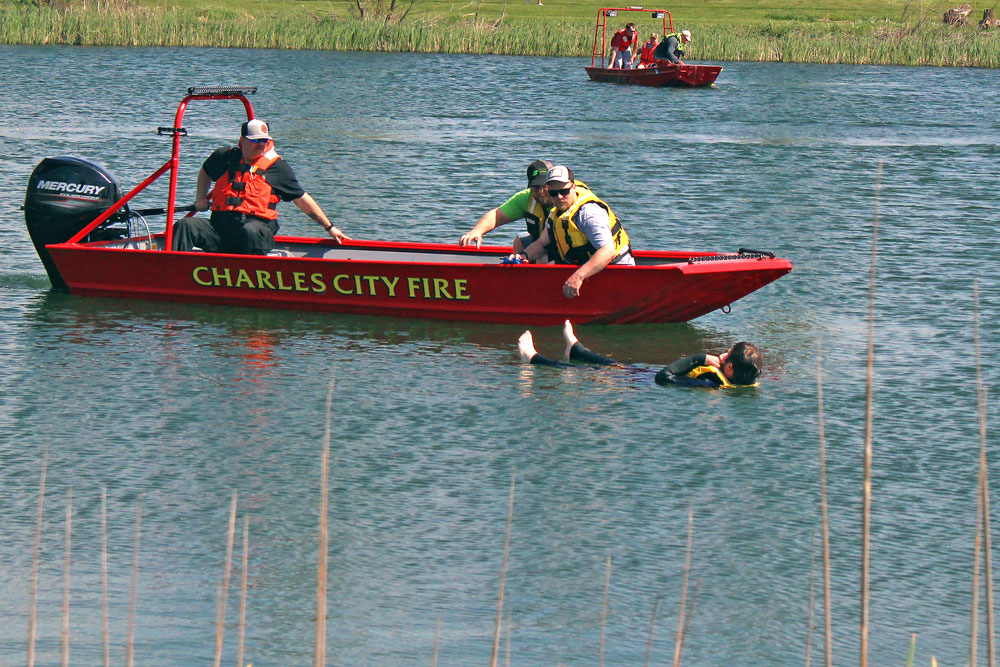Drought concerns grow as rain stays away from Floyd County

Enterprise Media Report
Only a third of the ag land in Floyd County has adequate topsoil moisture, according to the latest weekly crop report, and the weekly drought report shows most of the county in moderate drought, with a swath across the south of the county in severe drought.
The northcentral district of the state that includes Floyd County was rated 53% short and 14% very short for topsoil moisture, and just barely above half – 51% – adequate for subsoil moisture, the Crop Progress and Condition report by the Iowa Department of Agriculture and Land Stewardship and the U.S. Department of Agriculture reported this week.
 The lack of rain has area farmers starting to worry about how much more drought their fields can take.
The lack of rain has area farmers starting to worry about how much more drought their fields can take.
“It’s becoming more and more concerning,” said Terry Basol, ISU Extension agronomist who is based at the Northeast Iowa Research Farm near Nashua. “You don’t even need to go out into a field to see how dry it is. Look at our lawns. They look like August.”
He said his biggest concern for area farmers is how the drought is affecting corn plants.
He said those plants are in the “V5, V6 range,” which is the time that the plant is “making a decision.”
“It’s basically deciding right now just what kind of girth can I put on that ear,” Basol said. “It’s thinking to itself, ‘I don’t have the moisture to support it.’”
Basol said hybrid seeds do a much better job of dealing with drought conditions, but without rain the yields will still suffer.
It has dried up in a hurry around Northeast Iowa.
According to data from the National Weather Service, Charles City has received in June so far less than one-third of an inch of rain – 0.31 inches – through Thursday of this week.
The average amount of rainfall for June in Charles City is 4.36 inches, so with almost three-quarters of the month already gone, the area is far below average.
In May, Charles City received just 1.77 inches, far less than the normal average of 5.15 inches for the month. For the first five months of this year, January through May, Charles City received 10.75 inches of precipitation, compared with the normal average amount in those five months of almost 13 inches.
Basol said, “We’re looking at some major deficits, and it’s stressing the corn especially and concerning our growers, too.”
He did say that, at least for now, he’s less concerned about area soybean fields.
“They’re just hanging out right now, but when it does come to the reproduction, flowering stages, they’re going to need some moisture, too,” he said. “It’s not like we’re in a total crisis situation yet, but it’s amazing how much we’ve dried up in a month’s time.”
The forecast for the next several days is 46% chance of rain Saturday, with about a quarter of an inch possible; and 73% Sunday, with about a third of an inch possible.
Basol, though, said he is not holding his breath.
“The last month, 50 percent has meant 10 percent and 20 percent has meant virtually zero chance,” he said. “I hope for once 50 percent means 100 percent, because it’s getting a little desperate out in those fields right now.”
The U.S. Drought Monitor’s weekly report that was released Thursday showed almost the entire state ranging from extremely dry to extreme drought.
Floyd and Chickasaw counties were mostly listed as moderate drought, with the bottom part of each county listed as severe drought. Just a small section of Osceola and Dickinson counties in northwest Iowa were listed as no drought.
About 83% of the state is suffering from some degree of drought, according to the report. That’s up from about 68% the week before.
And the total area that has “extreme” drought — the second-worst classification used by the Drought Monitor — more than quadrupled since last week.
That level of dryness has for months been relegated to an area near Sioux City. There is now a pocket of extreme drought near Council Bluffs in southwest Iowa and a wider swath has developed near the Missouri border in southeast Iowa.
“We’ve just been stuck in that stagnant, high-pressure, omega blocking,” State Climatologist Justin Glisan said of the atmospheric condition centered over southern Canada that has been disrupting the northern hemisphere’s jet stream for weeks.
“It just backs up the entire west-east flow and, hence, rapid-onset drought across the state,” he said.
The total area of the state suffering from drought has more than tripled in the past month, though wetter days are predicted to lie ahead. The questions is: when?
“You have to shake this configuration at some point,” Glisan said. “The storm track that we’re seeing this weekend, and then the shorter-term outlooks, are suggesting that within the next several weeks we should see a shift.”
Significant, widespread rainfall is expected this weekend, according to the National Weather Service, but a string of warm and sunny days are expected to follow.
Iowa’s drought is the worst it’s been at this time of the year in more than a decade. The overall dryness is comparable to 2021, which trended wetter as that year progressed.
Timely rains in 2021 led to highest average corn yields ever in Iowa, at 204 bushels per acre.
In 2012, which had the worst yields by far of the past two decades, the overall dryness of the state was much better in June, but conditions quickly deteriorated into one of the worst droughts ever recorded for Iowa.
Corn’s water usage typically peaks in July as the plant develops tassels to spread pollen.
— By Bob Fenske of the New Hampton Tribune, Bob Steenson of the Charles City Press, and Jared Strong of Iowa Capital Dispatch.









Social Share